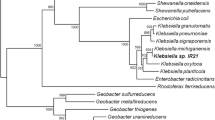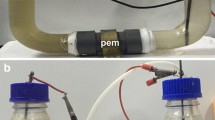Abstract
As electrochemically active bacteria play an important role in microbial fuel cells (MFCs), it is necessary to get a comprehensive understanding of their electrogenesis mechanisms. In this study, a new electrochemically active bacterium, Klebsiella sp. ME17, was employed into an “H” typed MFC for electrogenesis, with glucose as the electron donor. The maximum power density was 1,209 mW/m2 at a resistance of 340 Ω and the maximum current was 1.47 mA. Given the original anode medium, fresh medium, and the supernatant of the anode medium in the same MFC, respectively, the polarization curves illustrated that the strain produced mediators to promote extracellular electron transfer. The anode medium supernatant was electrochemically active, based on cyclic voltammogram, and the supernatant was very likely to contain quinone-like substances, as indicated by spectrophotometric and excitation–emission matrix fluorescence spectroscopy analysis. Further investigation on the color and ultraviolet absorbance at 254 nm of the filtered anode medium showed that the redox states of mediators strongly associated with the electricity generation states in MFCs.







Similar content being viewed by others
References
Babaei A, Connor PA, McQuillan AJ, Umapathy S (1997) UV-visible spectroelectrochemistry of reduction products of anthraquinone in dimethylformamide solutions-An advanced undergraduate experiment. J Chem Educ 74:1200–1204
Bond DR, Lovley DR (2003) Electricity production by Geobacter sulfurreducens attached to electrodes. Appl Environ Microbiol 69:1548–1555
Bond DR, Holmes DE, Tender LM, Lovley DR (2002) Electrode-reducing microorganisms that harvest energy from marine sediments. Science 295:483–485
Cao XX, Huang X, Boon N, Liang P, Fan MZ (2008) Electricity generation by an enriched phototrophic consortium in a microbial fuel cell. Electrochem Commun 10:1392–1395
Chen W, Westerhoff P, Leenheer JA, Booksh K (2003) Fluorescence excitation-emission matrix regional integration to quantify spectra for dissolved organic matter. Environ Sci Technol 37:5701–5710
Chu J, Hu R, Miwa T, Takeuchi T (1995) Indirect photometric detection of inorganic anions by microcolumn liquid-chromatography using anthraquinone-disulfonate as visualization agent. Chromatographia 40:379–381
Coates JD, Cole KA, Chakraborty R, O'Connor SM, Achenbach LA (2002) Diversity and ubiquity of bacteria capable of utilizing humic substances as electron donors for anaerobic respiration. Appl Environ Microbiol 68:2445–2452
Cory RM, McKnight DM (2005) Fluorescence spectroscopy reveals ubiquitous presence of oxidized and reduced quinones in dissolved organic matter. Environ Sci Technol 39:8142–8149
Curtis GP, Reinhard M (1994) Reductive dehalogenation of hexachlorethane, carbon-tetrachloride, and bromoform by anthrahydroquinone disulfonate and humic-acid. Environ Sci Technol 28:2393–2401
Freguia S, Rabaey K, Yuan Z, Keller J (2008) Sequential anode-cathode configuration improves cathodic oxygen reduction and effluent quality of microbial fuel cells. Water Res 42:1387–1396
Freguia S, Masuda M, Tsujimura S, Kano K (2009) Lactococcus lactis catalyses electricity generation at microbial fuel cell anodes via excretion of a soluble quinone. Bioelectrochemistry 76:14–18
Gorby YA, Yanina S, McLean JS, Rosso KM, Moyles D, Dohnalkova A, Beveridge TJ, Chang IS, Kim BH, Kim KS, Culley DE, Reed SB, Romine MF, Saffarini DA, Hill EA, Shi L, Elias DA, Kennedy DW, Pinchuk G, Watanabe K, Ishii S, Logan B, Nealson KH, Fredrickson JK (2006) Electrically conductive bacterial nanowires produced by Shewanella oneidensis strain MR-1 and other microorganisms. Proc Natl Acad Sci U S A 103:11358–11363
Jin W, Fan JC (1997) Study on the UV (254 nm) absorbance as a surrogate parameter of organic matter. Ind Water Treat 17:30–32 (in Chinese)
Kim GT, Webster G, Wimpenny JWT, Kim BH, Kim HJ, Weightman AJ (2006) Bacterial community structure, compartmentalization and activity in a microbial fuel cell. J Appl Microbiol 101:698–710
Liang P, Fan MZ, Cao XX, Huang X (2009) Evaluation of applied cathode potential to enhance biocathode in microbial fuel cells. J Chem Technol Biotechnol 84:794–799
Logan BE, Hamelers B, Rozendal R, Schrorder U, Keller J, Freguia S, Aelterman P, Verstraete W, Rabaey K (2006) Microbial fuel cells: methodology and technology. Environ Sci Technol 40:5181–5192
Lovley DR (2008) The microbe electric: conversion of organic matter to electricity. Curr Opin Biotechnol 19:564–571
Lovley DR, Coates JD, Blunt-Harris EL, Phillips EJP, Woodward JC (1996) Humic substances as electron acceptors for microbial respiration. Nature 382:445–448
Lower SK Jr, MFH BTJ (2001) Bacterial recognition of mineral surfaces: nanoscale interactions between Shewanella and α-FeOOH. Science 292:1360–1363
Marsili E, Baron DB, Shikhare ID, Coursolle D, Gralnick JA, Bond DR (2008) Shewanella secretes flavins that mediate extracellular electron transfer. Proc Natl Acad Sci U S A 105:3968–3973
Newman DK, Kolter R (2000) A role for excreted quinones in extracellular electron transfer. Nature 405:94–97
Rabaey K, Boon N, Siciliano SD, Verhaege M, Verstraete W (2004) Biofuel cells select for microbial consortia that self-mediate electron transfer. Appl Environ Microbiol 70:5373–5382
Rabaey K, Boon N, Hofte M, Verstraete W (2005) Microbial phenazine production enhances electron transfer in biofuel cells. Environ Sci Technol 39:3401–3408
Reguera G, McCarthy KD, Mehta T, Nicoll JS, Tuominen MT, Lovley DR (2005) Extracellular electron transfer via microbial nanowires. Nature 435:1098–1101
Scott DT, McKnight DM, Blunt-Harris EL, Kolesar SE, Lovley DR (1998) Quinone moieties act as electron acceptors in the reduction of humic substances by humics-reducing microorganisms. Environ Sci Technol 32:2984–2989
Sund CJ, McMasters S, Crittenden SR, Harrell LE, Sumner JJ (2007) Effect of electron mediators on current generation and fermentation in a microbial fuel cell. Appl Microbiol Biotechnol 76:561–568
Wang Z, Wu Z, Tang S (2009) Characterization of dissolved organic matter in a submerged membrane bioreactor by using three-dimensional excitation and emission matrix fluorescence spectroscopy. Water Res 43:1533–1540
Xing DF, Zuo Y, Cheng SA, Regan JM, Logan BE (2008) Electricity generation by Rhodopseudomonas palustris DX-1. Environ Sci Technol 42:4146–4151
Zhang LX, Zhou SG, Zhuang L, Li WS, Zhang JT, Lu N, Deng LF (2008) Microbial fuel cell based on Klebsiella pneumoniae biofilm. Electrochem Commun 10:1641–1643
Zhang XY, Cheng SA, Wang X, Huang X, Logan BE (2009) Separator characteristics for increasing performance of microbial fuel cells. Environ Sci Technol 43:8456–8461
Zhao CG, Zheng J, Li HP, Wen GM, He YY, Yang SP, Dong C, Choi MMF (2009) Characterization of a methane-utilizing strain and its application for monitoring methane. J Appl Microbiol 106:2024–2030
Zuo Y, Xing DF, Regan JM, Logan BE (2008) Isolation of the exoelectrogenic bacterium Ochrobactrum anthropi YZ-1 by using a U-tube microbial fuel cell. Appl Environ Microbiol 74:3130–3137
Acknowledgments
This study was supported by the International Program of MOST (no. 2006DFA91120) of China and the Program of Introducing Talents of Discipline to Universities (the 111 Project).
Author information
Authors and Affiliations
Corresponding author
Rights and permissions
About this article
Cite this article
Xia, X., Cao, Xx., Liang, P. et al. Electricity generation from glucose by a Klebsiella sp. in microbial fuel cells. Appl Microbiol Biotechnol 87, 383–390 (2010). https://doi.org/10.1007/s00253-010-2604-5
Received:
Revised:
Accepted:
Published:
Issue Date:
DOI: https://doi.org/10.1007/s00253-010-2604-5




